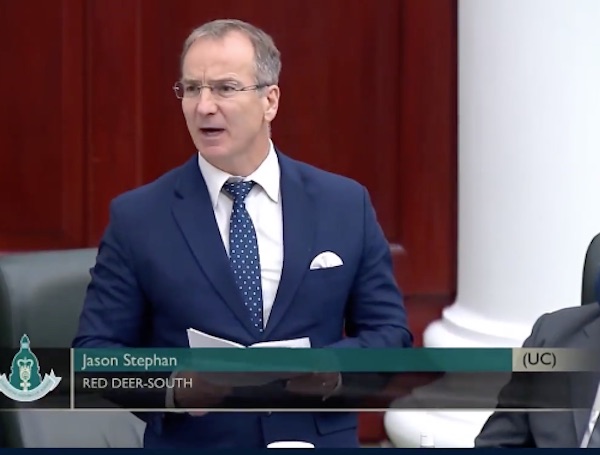Health
Time for an intervention – an urgent call to end “gender-affirming” treatments for children

From the Macdonald Laurier Institute
By J. Edward Les
Despite the Cass Review’s alarming findings, trans activists and their enablers in the medical professions continue to push kids into having dangerous, life-altering surgeries and hormone-blocking treatments. It needs to stop.
If nothing else, the scathing final report of the Cass Review released this week (but commissioned four years ago to investigate the disturbing practices of the UK’s Gender Identity Service), is a reminder that doctors historically are guilty of many sins.
Take the Tuskegee syphilis study, one of the greatest stains on the medical profession, in which impoverished syphilis-infected black men were knowingly deprived of therapy so that researchers could study the natural history of untreated disease.
Or consider the repugnant New Zealand cervical cancer study in the 1960s and 1970s, which left women untreated for years so that researchers could learn how cervical cancer progressed. Or the Swedish efforts to solidify the link between sugar and dental decay by feeding copious amounts of sweets to the mentally handicapped.
The doctors behind such scandals undoubtedly felt they were advancing scientific inquiry in pursuit of the greater good; but they clearly stampeded far beyond the boundaries of ethical medical practice.
More common by far, though, are medical “sins” committed unknowingly, such as when doctors prescribe toxic treatments to patients in the mistaken belief that they are beneficial. When physicians in Europe and Canada latched onto thalidomide in the late 1950s and early 1960s, for instance, they thought it was a wonder drug for morning sickness. Only the fine work of Dr. Francis Kelsey, an astute pharmacist at the FDA, prevented the ensuing birth-defects tragedy from being visited upon American women and children.
And when Oxycontin hit the medical marketplace in the 1990s, physicians embraced it as a marvellous — and supposedly non-addictive — solution to their patients’ pain. But the drug was simply another synthetic derivative of opium, and every bit as addictive; its use triggered a massive opioid overdose crisis — still ongoing today — that has killed hundreds of thousands and ruined the lives of countless individuals and their families.
Physicians in the latter instances weren’t driven by malevolence; but rather by a deep-seated desire to help patients. That wish, compounded by extreme busy-ness, repeatedly seduces doctors into unwarranted faith in untested therapies.
And no discipline in medicine, arguably, is more frequently led astray by the siren song of shiny new things than the field of psychiatry. Which is understandable, perhaps, given the nature of psychiatric practice. Categorizations of mental disorders — and the methods used to treat them — are based almost entirely on consensus opinion, rather than on direct measurement. Contrast that with other domains of medical practice: appendicitis is diagnosed by imaging the infected organ, and then cured by surgically removing the inflamed tissue; diabetes is detected by measuring elevated blood sugar, and then corrected by the administration of insulin; elevated blood pressure is calibrated in millimetres of mercury, and then effectively reduced with antihypertensives; and so on.
But mental disturbances remain largely the stuff of conjecture — learned conjecture, mind you, but conjecture, nonetheless. The Diagnostic and Statistical Manual of Mental Disorders, the “bible” of mental health professionals, is the collective effort of groups of tall foreheads gathered around conference tables opining on the various perturbations of the human mind. Imprecise definitions abound, with heaps of overlap between conditions.
The current version (DSM-5) describes schizophrenia, for example, as occurring on a spectrum of “abnormalities in one or more of the following five domains: delusions, hallucinations, disorganized thinking (speech), grossly disorganized or abnormal motor behavior (including catatonia), and negative symptoms.” Each of these five domains is open to professional interpretation; and what’s more, the schizophrenia spectrum is further subdivided into ten sub-categories.
That theme runs through the entire manual – and imprecise definitions lead on to imprecise solutions. Given the blurred indications for starting, balancing, and stopping medications, it’s no accident that many mentally unwell patients languish on ever-changing cocktails of mind-altering drugs.
None of which is to downplay the enormous importance of psychiatry, which does much to address human suffering amidst unimaginable complexity; its practitioners are among the brightest and most capable members of the medical profession. But by its very nature the discipline is submerged in — and handicapped by — uncertainty. It’s unsurprising, then, that mental health professionals desperate for effective treatments are susceptible to being misled.
The dark history of frontal lobotomies, seized upon by psychiatrists as a miracle cure but long relegated to the trash heap of medical barbarism, is well known. The procedure (which garnered its inventor the Nobel Prize in Medicine) basically consisted of driving an ice pick through patients’ eye sockets to destroy their frontal lobes; thousands of patients were permanently maimed before saner heads prevailed and the practice was halted. Many of its victims were gay men: “conversion therapy” with a literal, brain-altering “punch.”
Similarly, the fabricated “recovered memories of sexual abuse” saga of the 1980s and early 1990s suckered mental health practitioners into believing it was legitimate. Hundreds of professional careers were built on the “therapy” before it was all exposed as a fraud, leaving many lives ruined, families torn asunder, and scores of innocent men imprisoned or dead from suicide. In a 2005 review, Harvard psychology professor Richard McNally pegged the recovered memory movement as “the worst catastrophe to befall the mental health field since the lobotomy era.”
Until now, that is. That scandal pales in comparison to the “gender transition/gender affirming care” craze that has befogged the medical profession in recent years.
Without a shred of supporting scientific evidence, many doctors — led by psychiatrists, but aided and abetted by endocrinologists, surgeons, pediatricians, and family doctors — have bought into the mystical notion of gender fluidity. What was previously recognized as “gender identity disorder” was rebranded as gender “dysphoria” and recast as part of the normal spectrum of human experience, the basic truth of binary mammalian biology simply discarded in favour of the fiction that it’s possible to convert from one sex to another.
Much suffering has ensued. The enabling of biological males’ invasion of women’s spaces, rape shelters, prisons, and sports is bad enough. But what is being done to children is the stuff of horror movies: doctors are using medications to block physiological puberty as prologue to cross-gender hormones, genital-revising surgery, and a lifetime of infertility and medical misery — and labelling the entire sordid mess as gender-affirming care.
The malignant fad began innocently enough, with a Dutch effort in the late 1980s and early 1990s to improve the lot of transgendered adults troubled by the disconnect between their physical bodies and their gender identity. Those clinicians’ motivations were defensible, perhaps; but their research was riddled with ethical lapses and methodological errors and has since been thoroughly discredited. Yet their methods “escaped the lab”, with the international medical community adopting them as a template for managing gender-confused children, and the World Professional Association for Transgender Health (WPATH) enshrining them as “standard of care.” Then, as American social psychologist Jonathan Haidt is the latest to observe, the rise of social media torqued the trend into a craze by convincing hordes of adolescents they were “trans.” Which is how we ended up where we are today, with science replaced by rabid ideology — and with condemnation heaped upon anyone who dares to challenge it.
An explanation sometimes offered for the massive spike in gender-confused kids seeking “affirmation” in the past fifteen years is that today it’s “safe” for kids to express themselves, as if this phenomenon always existed but that — as with homosexuality — it was “closeted” due to stigma. Yet are we really expected to believe that the giants of empirical research into childhood development —brilliant minds like Jean Piaget, Eric Erikson, Lev Vygotsky, and Lawrence Kohlberg — somehow missed entirely the trait of mutable “gender identity” amongst all the other childhood traits they were studying? That’s nonsense, of course. They didn’t miss it — because it isn’t real.
The fog is beginning to dissipate, thankfully. Multiple jurisdictions around the world, including the UK, Sweden, Norway, Finland, and France have begun to realize the grave harm that has been done, and are pulling back from — or halting altogether — the practice of blocking puberty. And the final Cass Report goes even further, taking square aim at the dangerous practice of social transitioning and concluding that it’s “not a neutral act” but instead presents risk of grave psychological harm.
All of which places Canada in a rather awkward position. Because in December of 2021 parliamentarians gave unanimous consent to Bill C-4, which bans conversion therapy, including “any practice, service or treatment designed to change a person’s gender identity.” It’s since been a crime in Canada, punishable by up to five years in prison, to try to help your child feel comfortable with his or her sex.
As far as I know, no one has been charged, let alone imprisoned, since the bill was passed into law. But it certainly has cast a chill on the willingness of providers to deliver appropriate counselling to gender-confused children: few dare to risk it.
A conversion therapy ban had been in the works for years, triggered by concerns about disturbing and harmful practices targeting gay children. But by the time the bill was presented in its final form to Parliament for a vote it had been hijacked by trans activists, with its content perverted to the degree that there is more language in the legislation speaking to gender identity than to homosexuality.
To be clear, likening homosexuality to pediatric “gender fluidity” is a category error, akin to comparing apples to elephants. The one is an innate sexual orientation, the acceptance of which requires simply leaving people be to live their lives and love whomever they wish; the other is wholly imaginary, the acceptance of which mandates irreversible medical (and often surgical) intervention and the transformation of children into lifelong (and usually infertile) medical patients.
And the real “elephant” in the room is that in a troubling number of cases pediatric trans care is conversion therapy for gay children because for some people, it’s more acceptable to be trans than it is to be gay.
Bill C-4 received unanimous endorsement from all parliamentarians, including from Pierre Poilievre, now the leader of the Conservative Party. No debate. No analysis. Just high-fives all around for the television cameras.
It’s possible that many of the opposition MPs hastening to support the ban did so for fear of being painted as bigots. Yet the primary responsibility of an opposition party in any healthy democracy is to oppose, even when it’s unpopular. In 2015, when NDP Opposition leader Tom Mulcair faced withering criticism for resisting anti-terror legislation tabled by Stephen Harper’s Conservative government, he cited John Diefenbaker’s comments on the role of political opposition:
“The reading of history proves that freedom always dies when criticism ends… The Opposition finds fault; it suggests amendments; it asks questions and elicits information; it arouses, educates, and moulds public opinion by voice and vote… It must scrutinize every action of the government and, in doing so, prevents the shortcuts through democratic procedure that governments like to make.”
In the case of Bill C-4 the Conservatives did none of that. And by abdicating their responsibility they helped drive a metaphorical ice pick into the futures of scores of innocent children, destroying forever their prospects for normal, healthy lives.
We’re long overdue for a “conversion”: a conversion back to the light of reason, a conversion back to evidence-based care of children.
In 1962, when the harms of thalidomide became known, it was withdrawn from the Canadian market. In 2024, now that the serious harms of “gender-affirming care” have been exposed, it remains an open question as to when Canada’s doctors and politicians will finally take the difficult step of admitting that they got it wrong and put a stop to the practice.
Dr. Edward Les is a pediatrician in Calgary who writes on politics, social issues, and other matters.
Addictions
The Death We Manage, the Life We Forget

 Marco Navarro-Génie
Marco Navarro-Génie
Our culture has lost the plot about what it means to live.
Reading that Manitoba is bringing supervised consumption to Winnipeg got me thinking.
Walk through just about any major Canadian city, and you will see them. Figures bent forward at seemingly impossible angles, swaying in the characteristic “fentanyl fold,” suspended between consciousness and oblivion. They resemble the zombies of fiction: bodies that move through space without agency, awareness, or connection to the world around them. We think of zombies as the walking dead. Health workers and bureaucrats reverse their overdoses, send them back to the street, and call it saving lives.
At the same time, Canada offers medical assistance in dying to a woman who cited chemical sensitivities and the inability to find housing. It has been offered to veterans who asked for support and were met instead with an option for death. We fight to prevent one form of death while facilitating another. The contradiction is not accidental. It reveals something about the people involved and the funding behind it. That’s our culture. Us. It appears to me that our culture no longer knows what life is.
Ask any politician or program bureaucrat, and you will hear them explain, in the dry language of bureaucracy, that the twin approach to what they call harm reduction and medical assistance in dying (MAiD) rests on the shared premise of what they believe to be compassion. They think they respect autonomy, prevent suffering, and keep people alive when possible. It sounds humane. It is, in practice, incoherent. Bear with me for a moment.
The medical establishment administers naloxone to reverse overdoses in people who spend as many as twenty hours a day unconscious. They live without meaningful relationships or memories, with little capacity for choice. The technocrats and politicians call that saving lives. They also provide assisted death to people whose suffering comes primarily from poverty, isolation, or lack of housing. There was a time when these factors could, at least in theory, be addressed so that the terminal decision did not need to be made. Now they are accepted as grounds for ending life.
But why is one preference final and the other treated as an error to correct? That question reflects the deeper disorientation.
We saw the same thing during COVID. Elderly people in care homes were left without touch, family, or comfort for days. They often died in solitude, their dementia accelerated by isolation. And those conditions were inflicted upon them in the name of saving their lives. The “system” measured success in preventing infections, not in preserving connections. Je me souviens. Or we should.
There is a pattern here. We have reduced the idea of saving lives to keeping bodies breathing, while ignoring what makes a life human: agency, meaning, development, and relationship. And in doing so, we begin to define life as mere biological persistence. But to define life by the capacity to breathe and perform basic functions is to place ourselves on the same footing as the non-human animals. It is to say, tacitly, that there is no fundamental distinction between a person and a creature. That, too, is a form of forgetting.
To be clear, the argument here is not that hopeless drug users should be administered MAiD. Instead, it is essential to recognize that the intellectual framework behind harm reduction and MAiD must be taken seriously, as it rests on some rationally defensible claims. In an age where most arguments are emotive and unexamined, the mildly logical has become strangely compelling.
It begins with the idea of autonomy. We cannot force others to live by our values. Every person must decide what makes life worth living. To insist otherwise is paternalism.
Then comes pragmatic compassion. People will use drugs whether we approve or not. People will find their lives unbearable, whether we acknowledge it or not. We can support them or moralize while they die.
There is also an emphasis on subjective experience. No one knows another’s pain. If someone says their suffering is intolerable, we are in no position to deny it, they say. If a user would rather face opioids than withdrawal and despair, are we entitled to interfere?
Finally, the comparison to medical ethics: we do not withhold insulin from diabetics who continue to eat poorly. We do not deny cancer treatment to smokers. Medicine responds to suffering, even when the patient has contributed to their condition. Harm reduction, they argue, simply applies that principle to addiction.
These arguments produced tangible benefits, they argue. Needle exchanges reduced HIV transmission. Naloxone kits prevented deaths. Safe injection sites meant fewer people dying alone. MAiD brought relief to those in agony. These were not trivial outcomes. I am aware.
Yet when we look more closely, the very logic that underlies these policies also exposes their fatal limitations.
Addiction undermines choice. It hijacks the brain’s ability to reason, compare, and choose. A person deep in addiction is not selecting between alternatives like someone choosing coffee or tea. The structure of choice, the human will, itself is broken. The addiction decides before the person does. St Augustine knew this. Dostoyevsky knew it too.
And for the empirically minded, the research supports this. In British Columbia, where the “safe supply” model was pioneered, some addiction physicians now say the policy is failing. Worse, it may be creating new opioid dependencies in people who were not previously addicted. A study earlier this year found that opioid‑related hospitalizations increased by about 33 percent, compared with pre‑policy rates. With the later addition of a drug-possession decriminalization policy, hospitalizations rose even more (overall, a 58 percent increase compared to before SOS’s implementation). The study concluded that neither safer supply nor decriminalization was associated with a statistically significant reduction in overdose deaths. This is not freedom. It is a new form of bondage, meticulously paved by official compassion.
Despair disguises itself as autonomy, especially in a spiritually unmoored culture that no longer knows how to cope with suffering. A person requesting assisted death because of chronic, untreatable pain may appear lucid and composed, but lucidity is not the same as wisdom. One can reason clearly from false premises. If life is reduced to the absence of pain and the preservation of comfort, then the presence of suffering will seem like failure, and death will appear rational. But that is not a genuine choice because it is based on a misapprehension of what life is. All life entails pain. Some of it is redemptive. Some of it is endured. But it does not follow that the presence of suffering justifies the conclusion of life.
Someone turning to drugs because of homelessness, abandonment, or despair is often in an even deeper eclipse of the will. Here, there is not even the appearance of deliberation, only the reach for numbness in the absence of meaning. What looks like a decision is the residue of collapse. We are not witnessing two forms of autonomy, one clearer than the other. We are witnessing the breakdown of autonomy in various forms, and pretending that it is freedom.
Biological survival is not life. When we maintain someone in a state of near-constant unconsciousness, with no relationships, no capacity for flourishing, we are not preserving life. We are preserving a body. The person may already be gone. To define life as nothing more than breathing and performing bodily functions is to deny what makes us human. It reduces us to the level of non-human creatures, sentient, perhaps, but without reason, memory, moral reflection, or the possibility of transcendence. It tacitly advances the view that there is no essential difference between a person and a critter, so long as both breathe and respond to some stimuli.
Governments do these things to keep ballooning overdosing deaths down, preferring to maintain drugs users among the undead instead. That reminds me of how the Mexican government hardly moves a finger to find the disappeared, 100,000 strong of lately. For as long ss they’re disappeared, they choose not to count them as homicides, and they feel justified in ignoring the causes of all the killing around them.
Some choices are nefarious. Some choices deserve challenge. Not all autonomous acts are equal. The decision to continue living with pain, or to fight addiction, requires agency. The decision to surrender to despair may signal the absence of it. To say all choices are equal is to empty the word autonomy of meaning.
This reflects a dangerously thin view of the human person that permeates our present. What we now call “harm” is only death or physical pain. What we call good is whatever someone prefers. But people are more than collections of wants.
We should have learned this by now. In Alberta, safer supply prescribing was effectively banned in 2022. Officials cited diversion and lack of measurable improvement. We are forcing some people into treatment because we recognize the impairment of judgement in addiction.
In British Columbia, public drug use was quietly re-criminalized after communities rebelled. This was an admission of policy failure. “Keeping people safe is our highest priority,” Premier David Eby said. Yet safe supply remains. In 2023, the province recorded more than 2,500 overdose deaths. Paramedics continue to respond to thousands of overdose calls each month. This is not success. It is a managed collapse.
Meanwhile, Manitoba is preparing to open its own supervised drug-use site. Premier Wab Kinew said, “We have too many Manitobans dying from overdose… so this is one tool we can use.” That may be so. However, it is a tool that others are beginning to set aside. It is a largely discredited tool. Sadly, in the self-professed age of “Reconciliation” with Aboriginal Canadians, Aboricompassionadians are disproportionately affected by these discredited policies.
The Manitoba example illustrates the broader problem, despite damning evidence. Instead of asking what helps people live, we ask whether they gave consent. We do not ask whether they were capable of it. We ask whether they avoided death. We do not ask whether they found purpose.
We are not asking what might lead someone out of addiction. We are not asking what they need to flourish. We ask only what we can do to prevent them from dying in the short term. And when that becomes impossible, technocracy offers them death in a more organized form, cleanly approved by government. That’s compasson.
The deeper problem is not policy incoherence. It is the cultural despair that skates on the thin ice of meaninglessness. These policies make sense only in a culture that has already decided life is not worth too much. What matters is state endorsement and how it’s done .
It is more cost-effective to distribute naloxone than to construct long-term recovery homes. It is easier to train nurses to supervise injection than to provide months of residential treatment. It is far simpler to legalize euthanasia for the poor and the suffering than to work on solutions that lift them out of both. But is it right?
This is not compassion. It is surrender.
A humane policy would aim to restore agency, not validate its absence. It would seek out what helps people grow in wisdom and self-command, not what leaves them comfortably sedated. It would measure success not in lives prolonged into darker dependency but in persons recovered. In lives better lived.
This vision is harder. It costs time. It requires greater effort. It requires care and what some Christians call love of neighbour. It may require saying no when someone asks for help that could lead to ruin. But anything less is not mercy. It is a slow walk toward death while we leave the “system” to pretend there is no choice.
We did have a choice. We chose shallow comfort over deep obligation. We chose to manage symptoms rather than confront the deeper conditions of our age: loneliness, meaninglessness, despair. And now we live among the results: more, not fewer, people swaying in silence, already gone walking dead.
We might ask what we’ve forgotten about suffering, about responsibility, about what life is. Lives are at stake. True. But when our understanding of life is misdirected, so will be the policies the state gives us.
We are grateful that you’re reading Haultain Research.
For the full experience, and to help us bring you more quality research and commentary,
Bruce Dowbiggin
Healthcare And Pipelines Are The Front Lines of Canada’s Struggle To Stay United

Ottawa and Alberta have reached a memorandum of understanding that paves the way for, among other things,. a new oil pipeline in return for higher carbon taxes.. How’s it doing? B.C. and Quebec both reject the idea. The Liberals former Climate minister resigned his cabinet post.
The most amazing feature of the Mark Carney/Danielle Smith MOU is that both politicians feverishly hope that the deal fails. Carney can tell Quebec that he tried to reason with Smith, and Smith can say she tried to meet the federalists halfway. Failure suits their larger purposes. Carney to fold Canada into Euro climate insanity and Smith into a strong motive for separation.
We’ll have more in. our next column. In the meantime, another Alberta initiative on healthcare has stirred up the hornets of single payer.
To paraphrase Winston Churchill, “Canada’s health system is the worst in the world. Except for all the other systems.” If there is anything left that Canadians agree upon it’s that their provincial healthcare plan is a disaster that needs a boatload of new money and the same old class rhetoric about two-tier healthcare.
Both prescriptions have been tried multiple times since Tommy Douglas made single-payer healthcare a reality. As a result today’s delivery systems are constantly strained to breaking and the money poured in to support it evaporates in red tape and vested interests.
But suggest that Canada adopt the method of somewhere else and you get back stares. Who does it better? How can we copy that? Crickets. Then ask governments to cut back and create efficiencies. No one wants to tell the unions they are the first to move. As a result, operating rooms sit empty for lack of trained nurses and rationed doctors. The system is all dressed with nowhere to go.

There are many earnest people trying their best to fit the square peg in the round hole. But so far it has produced a Frankenstein quilt of private clinics in other provinces handling overflows and American hospitals taking tens of thousands of overflows or critical cases. Ontarians travelling to Quebec for knee surgery. Albertans heading to eastern B.C. for hips and shoulders. Nova Scotians going to Boston for back surgery.
To say nothing of the legions of Canadians on waiting lists for terminal cancer or heart problems who, in despair of dying before seeing a specialist in 18-24 months, voyage to Lithuania, India or Mexico to save their lives. Everyone knows a story of a family member or friend surgery shopping. Every Canadian health authority sympathizes. But little solves the problem.
Which has led to predictable grumbling. @Tablesalt13 if the Liberals hadn’t surged immigration over the last 4-5 years and if all of the money spent on refugees and foreign aid was redirected to health care how much shorter would Canada’s medical waitlists be?

And if any small progress is made the radical armies opposed to two-tiered healthcare raise a stink in the media, stopping that progress in its tracks. Suggesting public/ private healthcare systems is a quick trip to a Toronto Star editorial and losing your next election.
Into the impasse Alberta has introduced Bill 11 to create a parallel private–public surgery system that allows surgeons to perform non-urgent procedures privately under set conditions, moving ahead with the premier’s announcement last week. The government says the approach will shorten wait times and help recruit doctors, while critics argue it risks two-tier care.
The legislation marks a major shift in healthcare reform in Alberta and faces (shock) strong opposition from the NDP which is pairing these reforms with the province’s use of the notwithstanding clause in banning radical trans surgery and medication for minors in the province.
There are examples of two-tiered healthcare elsewhere in the West. France, Ireland, Denmark, Switzerland and Germany, among others, use a dual-tracked system mixing public and private coverages. Reports FHI, “In the most successful European healthcare systems, e.g., Germany and Switzerland, the federal government handles the PEC risk, via national pools and government subsidies, sparing the burden on individual insurers.” While not perfect it hasn’t produced class warfare.
The Americans, meanwhile learned to their chagrin with ObamaCare (the Affordable Care Act, that government healthcare is not the answer. The U.S. heath system replaces government accounting with health insurance rationers as the immoveable force. Many Americans were outside this traditional system, paying out-of-pocket. Under the Obama plan everyone would be forced into a plan, like it or not.
The AFI continues, “ACA has a flawed design. Its architects meant to appeal to the public, promising what the old system could not fully deliver – guaranteed access to affordable health cover and coverage for pre-existing conditions (PECs). But they were wrong about being able to keep your doctor or your old policy if you wanted.
Previously individual policies had to exclude PEC coverage to be financially viable. Yet employer group policies often covered it after a waiting period, but the extra costs were spread over their fellow workers – a real burden on medium and small-sized companies. Under Obamacare, the very high PEC costs are still spread too narrowly – on each of the very few insurers who have agreed to stay as exchange insurers.”
In other words getting a universal system that helps the needy while not degrading treatment is illusory. Alberta is willing to admit that fact. Like agreement on pipelines it will face nothing but headwinds from the diehards (pun intended) who still believe Michael Moore’s fairy tales about a free system in Canada. And will do nothing to bind Canada’s warring factions.
Bruce Dowbiggin @dowbboy is the editor of Not The Public Broadcaster A two-time winner of the Gemini Award as Canada’s top television sports broadcaster, his new book Deal With It: The Trades That Stunned The NHL And Changed hockey is now available on Amazon. Inexact Science: The Six Most Compelling Draft Years In NHL History, his previous book with his son Evan, was voted the seventh-best professional hockey book of all time by bookauthority.org . His 2004 book Money Players was voted sixth best on the same list, and is available via brucedowbigginbooks.ca.
-

 Alberta2 days ago
Alberta2 days agoFrom Underdog to Top Broodmare
-

 Opinion22 hours ago
Opinion22 hours agoLandmark 2025 Study Says Near-Death Experiences Can’t Be Explained Away
-

 Focal Points23 hours ago
Focal Points23 hours agoSTUDY: TikTok, Instagram, and YouTube Shorts Induce Measurable “Brain Rot”
-

 Alberta21 hours ago
Alberta21 hours agoRed Deer’s Jason Stephan calls for citizen-led referendum on late-term abortion ban in Alberta
-

 Health24 hours ago
Health24 hours agoTens of thousands are dying on waiting lists following decades of media reluctance to debate healthcare
-

 Indigenous20 hours ago
Indigenous20 hours agoIndigenous activist wins landmark court ruling for financial transparency
-

 Alberta19 hours ago
Alberta19 hours agoCarney forces Alberta to pay a steep price for the West Coast Pipeline MOU
-

 Business18 hours ago
Business18 hours agoMan overboard as HMCS Carney lists to the right



